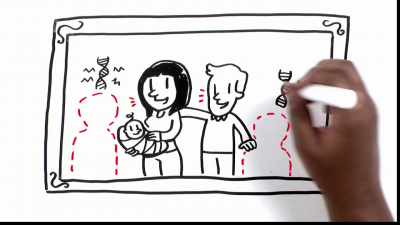Successful pregnancy with swyer syndrome
Description of a case with successful pregnancy in a 35-year-old patient with XY pure gonadal dysgenesis (Swyer's syndrome) and with chronic idiopathic hypertension that undergoes in vitro fertilization and embryo transfer .
Karyotyping is performed due to primary amenorrhea , diagnosis is confirmed and subsequently, a gonadectomy is performed, hormone replacement therapy is administered and hypertension is investigated.
The patient gets pregnant through an oocyte donation treatment and a live newborn by caesarean section.
Below you have an index with all the points that we will discuss in this article.
Index- 1. What is Swyer's syndrome?
- 2. Description of the case
- 3. Discussion
- 4. Bibliography
- 5. Authors and collaborators
What is Swyer's syndrome?
Swyer's syndrome, also known as XY gonadal dysgenesis, was first described in 1955 by Swyer.
They are tall patients with female external genitalia with a normal vagina, fallopian tubes, hypoplastic uterus but who have no developed secondary characters and have rudimentary gonads.
This genetic alteration is associated with a mutation for the SRY (sex-determining region of the Y chromosome) gene, which inhibits the Y chromosome's determining function that would cause the embryonic gonads to differentiate into testicles.
Description of the case
A woman born in 1975 who is being investigated for a primary amenorrhea at the age of 17 years. Karyotype performed on leukocytes provides a diagnosis of 46 XY with a normal Y chromosome structure. The results obtained together with other clinical tests (FSH, LH, estradiol, prolactin, testosterone, free testosterone, globulin-transporting sex hormone) reveal a diagnosis of Swyer's syndrome.
The gonads are removed to prevent them from degenerating into a malignant tumor or gonadoblastoma, receives hormone replacement therapy and ends up developing secondary characters and regular menstruation.
A few years later, the patient begins with a picture of high blood pressure, specifically the diastolic, and begin to perform tests of urine, blood, lipids, glucose, fat, creatinine, potassium, calcium, uric acid, etc., the results obtained they were not related to hypertension. The patient was treated with calcium blockers for short periods and a diet without salt.
The patient for 5 years expresses her desire to be a mother by donating oocytes. She underwent four IVF treatments with embryo transfer without success, in the fifth attempt 2 embryos were transferred and she became pregnant. In week seven of pregnancy pregnancy was confirmed by a gestational sac with normal beat.
Subsequently, normal and necessary controls were performed in the corresponding weeks of gestation, in week 12 a fetus is observed ultrasonographically without anatomical abnormalities. Before the end of the first trimester, high blood pressure is detected and methyldopa is administered.
The second-trimester ultrasound showed normal fetal growth and amniotic fluid volume. In the third trimester, the dose of methyldopa was increased, at week 32 an ultrasound was performed where all the parameters were normal.
In the 38th week of gestation after noticing less fetal movement, a cesarean was performed to avoid intrauterine fetal distress. The patient gave birth to a 2.9 kg child in good condition.


Bibliography
Creatsas G, Deligeoroglou E, Tsimaris P, Pantos K, Kreatsa M. Successful pregnancy in a Swyer syndrome patient with preexisting hypertension. Fertil Steril. 2011 Aug; 96 (2): e83-5.

Comments
Post a Comment